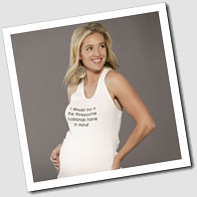 Yesterday one of our favorite customers, Kathryn, was in the store and had just found out the gender of her baby. I asked if she had a preference of boy or girl before she found out what it was and she said, "You know, I always heard people say it but never really believed it until I was in this position, but to be honest I didn't care what the gender was - as long as my baby was healthy". Even though this is her first pregnancy, that was spoken like a true mother.
Yesterday one of our favorite customers, Kathryn, was in the store and had just found out the gender of her baby. I asked if she had a preference of boy or girl before she found out what it was and she said, "You know, I always heard people say it but never really believed it until I was in this position, but to be honest I didn't care what the gender was - as long as my baby was healthy". Even though this is her first pregnancy, that was spoken like a true mother.
I think (and hope!) that most everyone who goes through those months of having a baby develop in their body is always concerned about the health of the baby, wanting to bring a perfectly happy child into the world. It's difficult to know what tests to have, since some of them can potentially be harmful to you or the baby. But on the flip side - not having them could put the baby at risk.
Many women undergo tests during pregnancy to check for birth defects, genetic disorders, and other problems. A few of the most common tests are ultrasound scans, the alpha-fetoprotein (AFP) test, amniocentesis, and chorionic villi sampling (CVS). Each of these can be helpful in diagnosing problems, but the tests are not necessary for every pregnancy. Check with your doctor about what tests, if any, are appropriate for you.
If any of you have had any experiences with one or more of these please comment about it. Everyone is different and your comments could help somebody going through your same situation.
ULTRASOUND - Ultrasound technology uses high-frequency sound waves to form pictures of the fetus on a computer screen. The test can verify a due date, determine causes of bleeding, check the overall health, development, sex and position of the baby, measure the amniotic fluid, and check the condition of the placenta. There are no known risks from the tests, and many women have one or two ultrasounds in routine pregnancies. However, there is little scientific evidence that normal pregnancies benefit from ultrasound tests.
ALPHA-FETOPROTEIN SCREENING (AFP) - A simple blood test that poses no risk to the fetus, AFP screening measures the levels of alpha-fetoprotein in the mother's blood. Abnormal levels can indicate a brain or spinal cord defect, the presence of twins, a miscalculated due date, or an increased risk of Down syndrome. Because AFP levels can be elevated for a number of reasons, a positive test is usually repeated or followed up by other tests before a diagnosis is made. Very few women with elevated AFP levels are found later to have babies with birth defects.
AMNIOCENTESIS - This test examines the cells shed by the fetus into the surrounding amniotic fluid. Performed about 16 weeks into pregnancy, the test involves inserting a long, thin needle through the mother's abdomen to extract fluid from the womb. The cells must be cultured in a laboratory and it may take up to a month for test results to be ready. The test is a reliable indicator of chromosomal abnormalities such as Down syndrome or genetic disorders such as Tay-Sachs disease, Hunter's syndrome, and others. While usually safe, amniocentesis can trigger cramping, leakage of amniotic fluid, and vaginal bleeding, and it may increase the risk of miscarriage by about 0.5 to 1 percent. The test is only done on women at increased risk of having babies with genetic disorders or to assess the maturity of the baby's lungs in the last trimester.
CHORIONIC VILLI SAMPLING (CVS) - Performed between 10 and 12 weeks of pregnancy, CVS can detect the same genetic abnormalities as amniocentesis. It involves inserting a catheter or needle into the womb and extracting some of the chorionic villi (cells from the tissue that will become the placenta). The chorionic villi contain the same chromosomes as the fetus. The test is relatively safe but it has a greater risk of miscarriage than amniocentesis. While there has been some concern that the test itself may be associated with limb deformities, many geneticists believe that CVS performed between 10 and 12 weeks of pregnancy does not increase that risk.
Comment away!
 You're pregnant, and people are just automatically going to look at you and notice your growing belly. So why not have fun with it?!
You're pregnant, and people are just automatically going to look at you and notice your growing belly. So why not have fun with it?!






